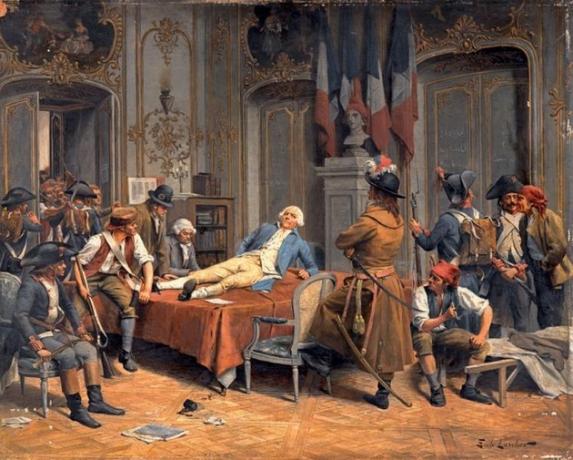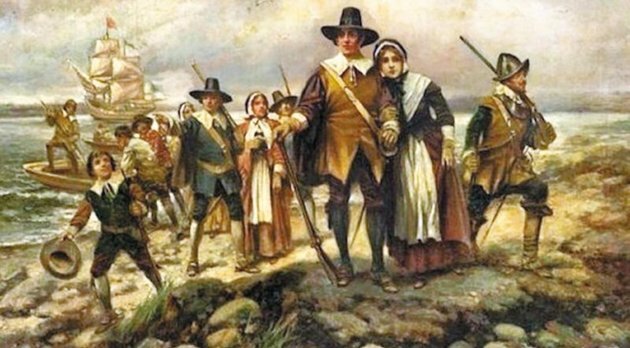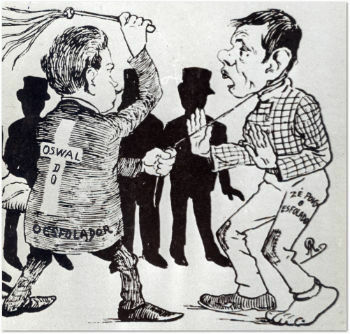O period of terror (1792-1794), during the French Revolution, was marked by religious and political persecution, civil wars, and guillotine executions.
At that time, France was being led by the Jacobins, considered the most radical among the revolutionaries, and that is why this period is also known as the "Jacobin Terror".
Horror Characteristics
In 1793, France had established the republican regime and was threatened by countries such as England, the Russian Empire and the Austro-Hungarian Empire.
Internally, different political currents such as the Girondins, Jacobins and noble émigrés struggled for power.
Thus, the Convention, which governed the country, adopted exceptional measures and suspended the Constitution of the First Republic and handed over the government to the Committee for Public Safety.
On this committee are the most radical members, called Jacobins, who have the Suspects Law passed on September 17, 1793, which should have been in effect for ten months.
This law made it possible to detain any citizen, male or female, who was suspected of conspiring against the French Revolution.
The Terror period made victims of all social conditions and the most famous guillotines were King Louis XVI and his wife, the Queen Marie Antoinette, both in 1793.
The symbol of this era, without a doubt, was the guillotine. This machine was recovered by physician Joseph Guillotin (1738-1814) who considered it a less cruel method than hanging or decapitation. During the Terror period, more than 15,000 deaths were recorded by this instrument.
Vendee War
The War of the Vendee (1793-1796) or Wars of the West was a peasant counter-revolutionary movement.
In the French region of Vendee, the peasants were dissatisfied with the course of the Revolution and the institution of the Republic. They were called “white” by the republicans, and for their part, these were the “blue ones”.
Peasants felt forgotten by the Republic that had promised equality, but taxes continued to rise. Likewise, when priests who had not sworn in the Constitution were banned from saying Mass, there was great discontent.
Thus, the population takes up arms under the motto "For God and the King". In this way, the movement is seen as a major threat by the central government and the repression was violent.
The conflict between whites and blues lasted for three years and an estimated 200,000 people died. Once the rebel army was defeated, the republicans started to destroy the villages and fields of cultivation, burn the forests and kill the cattle.
The aim was to provide an exemplary punishment so that counterrevolutionary ideas did not spread across France.
religious terror

The Jacobin terror did not spare the religious who refused to swear an oath on the Civil Constitution of the Clergy. For them, several laws were passed that provided for imprisonment and fines. Finally, the Law of Exile was passed on August 14, 1792 and about 400 priests had to leave France.
Likewise, a policy of dechristianization. The end of the monastic orders was decreed, churches were requisitioned to make room for the worship of the Being Supreme, the Christian calendar and religious festivals were abolished and replaced by festivals republicans.
Those monks who did not leave the convents were sentenced to death. The best known case was that of the Carmelites of Compiègne, when 16 nuns of the Order of Mount Carmel were sentenced to death by guillotine in 1794.
Social, cultural and economic measures
During the Jacobin period, in addition to violence, laws were passed that ended up shaping modern France. Some examples are:
- Abolition of slavery in the colonies;
- Fixing price limits for basic foodstuffs;
- Land confiscation;
- Assistance to the indigent;
- Replacement of the Gregorian calendar with the Republican one;
- Creation of the Louvre Museum, the Polytechnic School and the Conservatory of Music.
End of the Terror Period

The Jacobin party succumbed to infighting and the radicals tried to step up court executions in summary trials.
Ironically, party wing representatives at the end of the Terror were brought to the guillotine. On 9 Thermidor, 1794, the Swamp, a faction of the high financial bourgeoisie, strikes a coup, seizes power from the Jacobins and sends the popular leaders Robespierre (1758-1794) and Saint-Just (1767-1794) for the guillotine.
The disputes in France take place under the eyes of European leaders who are still afraid of political evolution. Therefore, in 1798 the Second Anti-French Coalition was formed, which brought together Great Britain, Austria and Russia.
Fearing the invasion, the bourgeois turn to the army, in the figure of the general Napoleon Bonaparte and this, in 1799, triggers the 18th of Brumário coup. It was an attempt to restore internal order and military organization against the external threat.
Brumaire 18 Strike: Bonaparte Comes to Power
O Brumaire 18 hit from 1799 was planned by the abbot Sieyès (1748-1836) and by Napoleon Bonaparte. Napoleon deposed the Directory using a column of grenadiers and implemented the Consulate regime in France. Thus, three consuls shared power: Bonaparte, Sieyès and Roger Ducos (1747-1816).
The trio coordinated the drafting of a new Constitution, promulgated a month later, which established Napoleon Bonaparte as first consul for a period of ten years. The Magna Carta still gave him dictator powers.
The dictatorship was used to defend the French from external threat. French banks granted a series of loans to support the wars and the maintenance of the achievements of the French Revolution.
Then begins the political and military rise of France on the European continent.
read more:
- French Revolution
- The Fall of the Bastille in the French Revolution
- National Constituent Assembly in the French Revolution
- French Revolution (Abstract)


